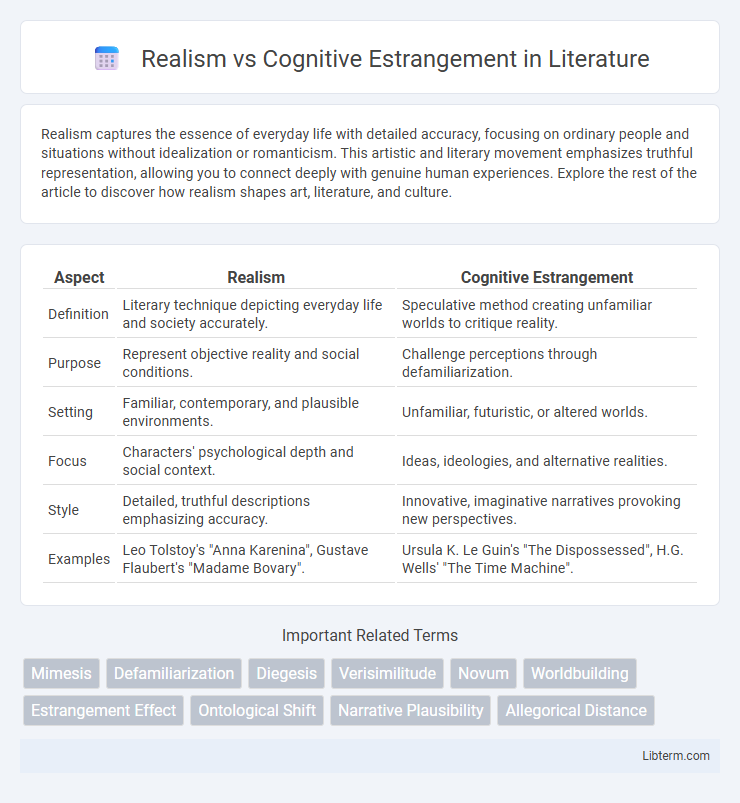Realism captures the essence of everyday life with detailed accuracy, focusing on ordinary people and situations without idealization or romanticism. This artistic and literary movement emphasizes truthful representation, allowing you to connect deeply with genuine human experiences. Explore the rest of the article to discover how realism shapes art, literature, and culture.
Table of Comparison
| Aspect | Realism | Cognitive Estrangement |
|---|---|---|
| Definition | Literary technique depicting everyday life and society accurately. | Speculative method creating unfamiliar worlds to critique reality. |
| Purpose | Represent objective reality and social conditions. | Challenge perceptions through defamiliarization. |
| Setting | Familiar, contemporary, and plausible environments. | Unfamiliar, futuristic, or altered worlds. |
| Focus | Characters' psychological depth and social context. | Ideas, ideologies, and alternative realities. |
| Style | Detailed, truthful descriptions emphasizing accuracy. | Innovative, imaginative narratives provoking new perspectives. |
| Examples | Leo Tolstoy's "Anna Karenina", Gustave Flaubert's "Madame Bovary". | Ursula K. Le Guin's "The Dispossessed", H.G. Wells' "The Time Machine". |
Introduction to Realism and Cognitive Estrangement
Realism in literature aims to depict everyday life and society with detailed accuracy, emphasizing ordinary characters and plausible events to reflect objective reality. Cognitive estrangement, a key concept in speculative fiction, introduces unfamiliar or altered elements to challenge readers' perceptions and provoke critical thinking about existing social, cultural, or political norms. Exploring the interplay between these approaches highlights how realism grounds narratives in recognizable worlds, while cognitive estrangement uses imaginative disruption to question and reframe reality.
Defining Realism in Literature and Art
Realism in literature and art emphasizes the accurate, detailed depiction of everyday life and ordinary people, rejecting idealization or romanticism. It focuses on observable reality, representing social conditions, behaviors, and environments with fidelity to promote a truthful understanding of the world. This artistic approach contrasts with cognitive estrangement by grounding its narratives and visuals in familiar, plausible contexts that reflect empirical experience.
Unpacking the Concept of Cognitive Estrangement
Cognitive estrangement is a key concept in science fiction theory, describing the process by which familiar realities are defamiliarized to provoke critical reflection. Unlike realism, which portrays the world as it is, cognitive estrangement introduces elements that disrupt normative perceptions, encouraging readers to question societal norms and envision alternative possibilities. This technique leverages speculative settings and scenarios to challenge assumptions, making it an essential tool for exploring ideological and cultural critiques within speculative fiction.
Historical Origins and Development
Realism, rooted in 19th-century literature, emphasizes accurate representation of everyday life and social conditions, originating with authors like Honore de Balzac and Gustave Flaubert. Cognitive estrangement, a concept central to science fiction theorist Darko Suvin, emerged in the 20th century as a means to defamiliarize reality through imaginative scenarios, challenging readers' perceptions and prompting critical reflection. The development of these approaches reflects a shift from mimetic representation toward speculative frameworks designed to interrogate contemporary ideological and social norms.
Key Theorists and Foundational Texts
Key theorists in Realism such as Aristotle and John Locke emphasize accurate representation and empirical observation in foundational texts like "Poetics" and "An Essay Concerning Human Understanding." Cognitive Estrangement, rooted in Darko Suvin's seminal work "Metamorphoses of Science Fiction," challenges realism by promoting a critical detachment through speculative fiction that reconfigures familiar realities. The debate is framed by these theorists' contrasting priorities of mimetic fidelity versus imaginative defamiliarization, shaping literary criticism and genre studies.
Comparative Analysis: Realism vs Cognitive Estrangement
Realism depicts the world with familiar settings and plausible scenarios, emphasizing accurate representation of everyday life and societal norms, while cognitive estrangement employs speculative or futuristic elements to challenge readers' perceptions by presenting unfamiliar realities. Realism grounds its narratives in relatable character motivations and plausible events, fostering empathy through recognition, whereas cognitive estrangement provokes critical reflection through imaginative constructs that disrupt conventional understanding. Comparing these approaches reveals how realism offers insight through reflection of actuality, whereas cognitive estrangement stimulates critical thought by defamiliarizing the known world.
Major Works Exemplifying Each Approach
George Orwell's "1984" stands as a major work exemplifying realism through its detailed depiction of a dystopian totalitarian regime grounded in political and social realities. In contrast, Ursula K. Le Guin's "The Left Hand of Darkness" showcases cognitive estrangement by presenting an alien society with radically different gender norms, prompting readers to question their own cultural assumptions. These works highlight realism's focus on believable worlds versus cognitive estrangement's challenge to readers' perceptions through speculative and unfamiliar settings.
Impact on Reader Perception and Interpretation
Realism grounds narratives in familiar, everyday experiences, fostering reader identification and immersive believability, which enhances emotional connection and straightforward interpretation. Cognitive estrangement, by contrast, introduces unfamiliar or speculative elements that disrupt normative expectations, prompting readers to critically reevaluate social, political, or philosophical assumptions. This contrast shapes reader perception by balancing relatability with critical distance, influencing the depth and nature of interpretative engagement.
Influence on Contemporary Genres and Media
Realism and cognitive estrangement distinctly shape contemporary genres and media by influencing narrative techniques and audience engagement strategies. Realism anchors stories in plausible settings and characters, enhancing relatability and immersion across dramas and historical fiction, while cognitive estrangement, a hallmark of speculative fiction, disrupts familiar realities to provoke critical reflection and imaginative exploration. This dynamic interplay enriches genres such as science fiction and fantasy, enabling creators to challenge societal norms and explore alternative futures through innovative world-building and thematic depth.
Conclusion: Significance and Ongoing Debates
Realism grounds narratives in familiar experiences, fostering immediate relatability and social critique, while cognitive estrangement challenges readers to envision alternative realities, promoting critical reflection on existing paradigms. The ongoing debate highlights their complementary roles in literature and media, as realism offers a mirror to society whereas cognitive estrangement serves as a tool for innovative thought and speculative critique. Understanding their significance enhances analysis of narrative strategies that shape cultural and ideological discourse.
Realism Infographic

 libterm.com
libterm.com